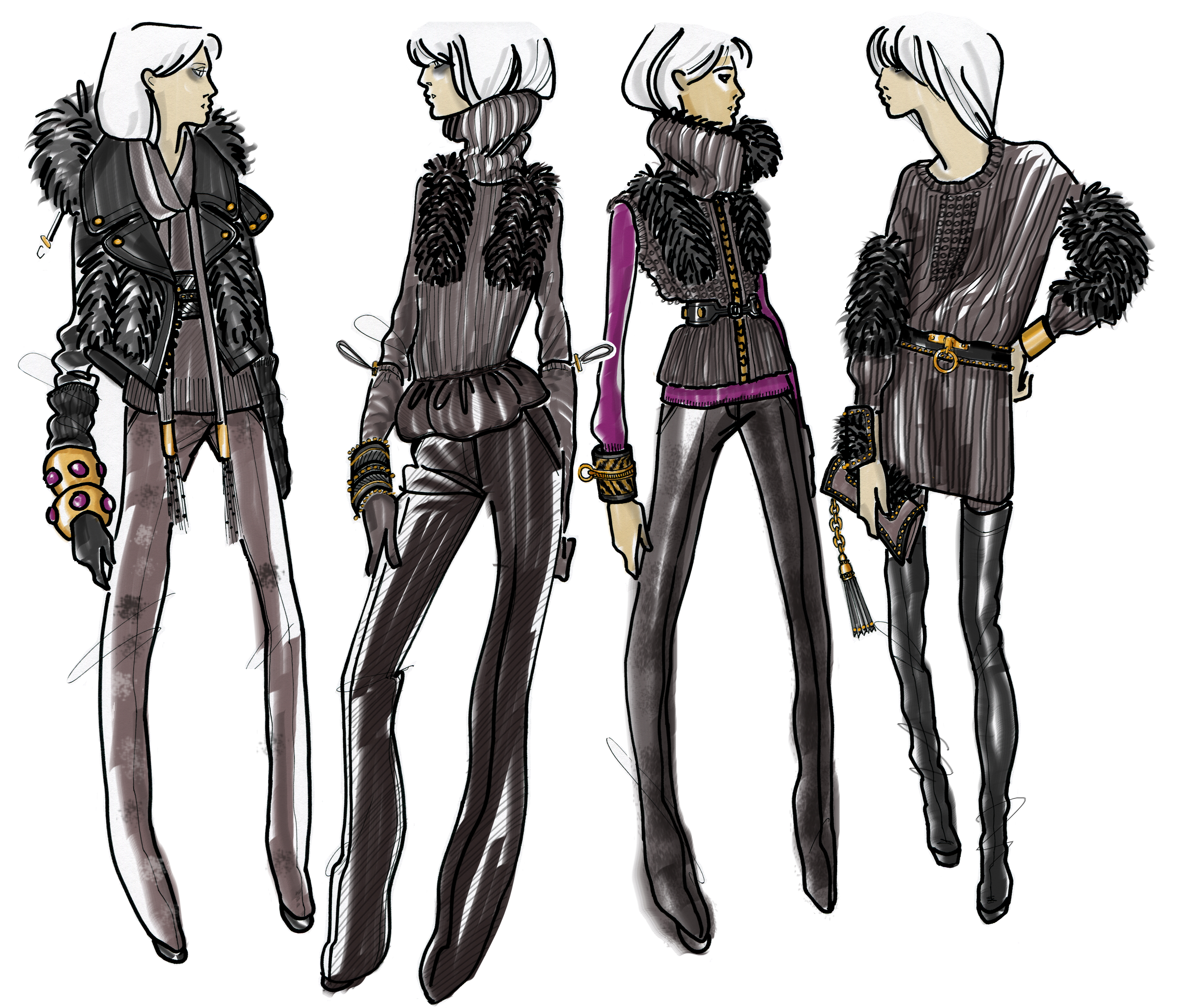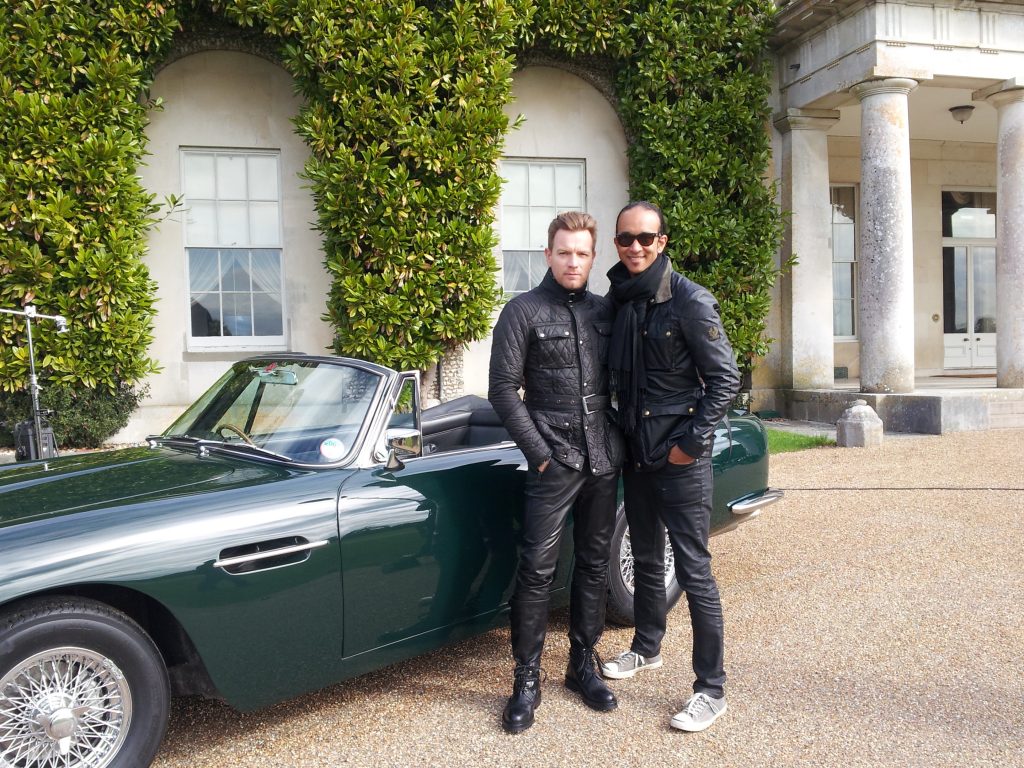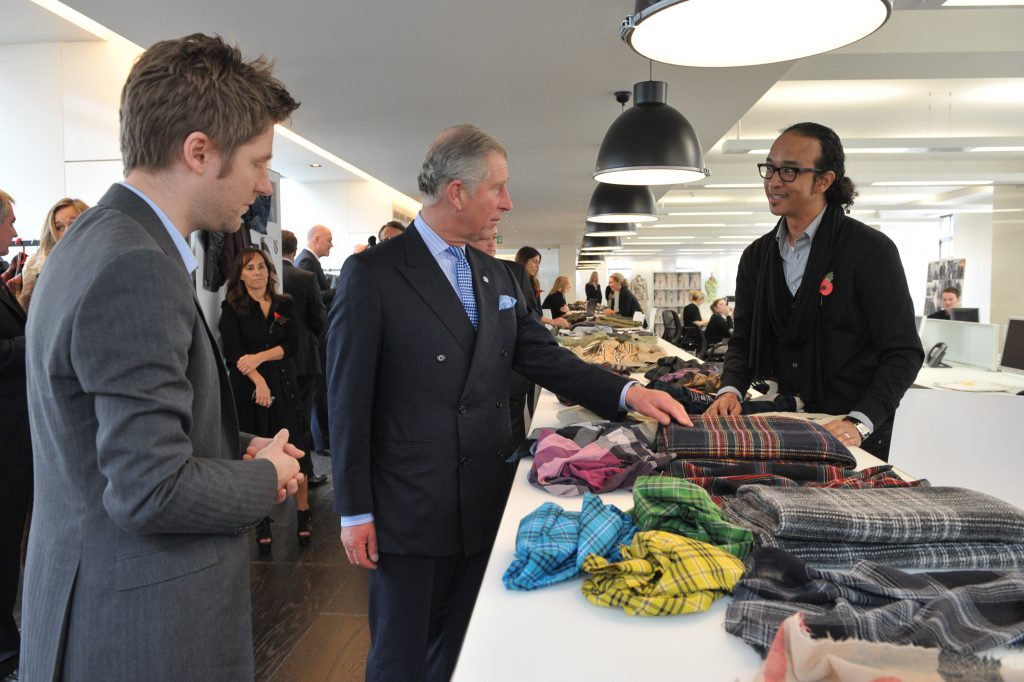
Fashion designer Martin Cooper in his London flat.
In the 1970s, while other Heathwood Hall students doodled stick figures, Martin Cooper was sketching beautiful evening gowns next to his algebra equations. “I never had to struggle to figure out what I wanted to do in life. I feel very blessed in that way. Fashion picked me,” Martin says. By age 11, Martin was designing full fashion collections at his childhood home on Pinehurst Road. With his newly finished sketches in tow, he would walk down a short pathway to find his grandmother next door. “My grandmother was my critic,” Martin says. “She was super gifted. She was ‘born before her time.’”

Ada Sawyer Cooper, Martin’s grandmother, graduated from the Pratt Institute in Brooklyn, New York, in 1922 with a degree in fashion design. When she returned to her native Bennettsville, Ada married Dr. Henry Cooper, and the couple built a large house on the Pinehurst Road property, which already included a cottage where Martin and his family later lived.
Ada bought Martin his first sewing machine and taught him how to draft patterns. “The most crucial lesson my grandmother taught me was never to trust a ruler. Trust your eye. Because there’s not one single straight line on the human body,” Martin says. “To this day, I build my clothes where they’re ergonomic to the human form. They curve and bend with you.”
Martin credits his Heathwood Hall science teacher, Sarah Magoffin, with understanding his creative spirit. “She got me. She knew I was operating in a different way, and she had respect for that.” He also has fond memories of Heathwood art teacher Salley (Ashley) Davis with whom he co-taught an art class his senior year. “I learned so much from Salley.”
Salley feels the same. She has followed Martin’s career and holds dear a sketch of a man’s blazer Martin once gave her. “I realized there was something amazing about Martin. I understood his brilliance. I’ve watched him grow and expand. I started as his teacher, but I became his friend and admirer. Martin taught me,” Salley says.
Martin has always trusted his inner compass. “Some might call it instinct, but it’s helped me navigate through life.” For instance, from a young age, Martin was certain he would live in New York City. He would open the Encyclopedia Britannica Volume N and go straight to New York. “There was a foldout of the island of Manhattan, and I’d memorize the order of the avenues because I knew I’d need that information later,” Martin says.
Martin’s New York prediction would be set in motion one summer at their family house at Myrtle Beach when a cousin from Manhattan suggested he look into Parsons School of Design. Martin became intrigued, and he and his mother, Carole — whom Martin calls his “muse” — drove to the Richland County Public Library to search for a phone number in the pre-internet days. Carole called Parsons, and Martin recalls her saying, “I have this child. We live in Columbia, South Carolina. He’s sketching and sketching and sketching. We have no idea what to do with him. What should we do?”
The person on the other end told them to send along examples of Martin’s work. He and Carole packed up his original sketches in a box and mailed them off to Parsons. A few months later, the chair of the fashion department called. “We loved Martin’s work. We’d like for him to join us for the college level course in the summer program,” Martin remembers her saying.
“Great! Terrific!” Martin recalls his mother replying. “But I haven’t told you. He’s only 14 years old.” After some discussions, Parsons agreed to let Martin attend its summer program following his sophomore year at Heathwood.
“That was a moment that literally changed my life,” Martin says. “I met a whole lot of kids who were just like me. That was a wonderful life affirmation.”

The following summer, Martin attended The South Carolina Governor’s School for the Arts and Humanities. “I loved it. I absolutely loved it,” he says. For college, he returned to Parsons, majoring in fashion design while also studying liberal arts at the New School in New York City. In 1986, Martin received the Norman Norell Memorial Award for Academic and Creative Excellence from Parsons.
While still in school, Martin worked with Jeffrey Banks, a well-known menswear designer, as well as Gloria Sachs, for whom he helped design a Seventh Avenue collection with the added bonus of trips to Italy. “During the weekends, we’d fly to Como and work with the best Italian silk printing mill in the world, and then I’d be back in class on Monday. That helped me leapfrog in my career,” Martin says.
In their final year, Parsons’ students are placed with a design critic. Marie Essex, Martin’s teacher and longtime friend, paired him with Calvin Klein. “I think you would get Calvin and Calvin would get you,” Martin recalls Marie saying. In a lovely synchronistic note, while he was growing up, Carole, Martin’s mother, almost exclusively wore Calvin or Anne Klein, which she bought at Britton’s when it was located in the original Richland Mall.
After graduation, Calvin Klein recruited Martin to help in designing an upcoming womenswear collection. One morning while at work, Martin called Parsons to ask if they could send over a student gifted in technical drawings. Later that day, in walked a confident woman named Karen Suen. “That was 1990, and we’ve been together every day since,” Martin says.
They married in 1994. Karen became a luxury leather goods designer, and she and Martin were the first couple to be inducted into CFDA, The Council of Fashion Designers of America, in the same year.
Martin became design director of outerwear at Burberry in 1994. “At the time, it was a very old, staid British heritage brand,” Martin says. He played a key role in the launch of Burberry Sport, and he oversaw the brand’s iconic Burberry trench, originally designed in 1912 by Thomas Burberry to protect military officers from wind and rain. “We collectively rebooted the brand,” Martin says. But the job was intense. “There was not a moment where you could lift your head up and bask in the sunlight. It was head down and ‘how do I get all of this done?’” Over his 16-year tenure, Martin helped Burberry become a billion-dollar business.
Martin goes on to say that the life of a designer is not all glamour. “It’s a hotel, visiting a factory, the airport, and then back to work with jet lag.” For 12 years, he commuted between New York and London until he and Karen settled in London, where their son, Pax, was born.
In 2010, Martin, Karen, and Pax returned to New York to be closer to family. Every Christmas, they travel to Columbia to see his mother, Carole, and brothers, Noble, a dentist, and Ford, an orthodontist. In fact, while Martin felt chosen by fashion, most other family members were drawn to dentistry. Both of his grandfathers as well as his father, brothers, uncle, and cousin were — and are — dentists.
When Martin is home, he and his mom reminisce about Noble, Martin’s father, who died in 2010. Noble and Carole had grown up together. When Noble returned from the Korean War, Carole was 18. Noble’s first dental office was on the old Waverly Hospital property, within walking distance of Carole’s house. “During lunchtime, Dad would go over, and he and Mom would do crossword puzzles on the porch. Mom then went to Fisk in Tennessee. She graduated and got married two weeks later.”
Martin’s mother is a cancer survivor, and in her honor, he and Karen formed OrchisArts, a nonprofit that supports grassroots breast cancer organizations focusing on patients’ care and welfare.
After the heavy workload at Burberry, Martin had planned for a year of rest and reflection, but another British heritage brand soon came calling, and Martin took over as chief creative officer of Belstaff. Founded in 1924, the company produced waxed jackets for motorcyclists, the most famous wearers being Steve McQueen and Amelia Earhart. Martin transformed the brand from utilitarian to luxury, infusing the classic motorcycle line with a burst of modernity, including punched leather blousons, parkas lined with black shearling, and billowing waxed motorcycle capes.
Following Martin’s re-energizing of Belstaff, he became creative director of Lands’ End; however, with constant commuting back and forth from New York to the headquarters in Wisconsin, his inner compass gradually led him in a new direction, and it all started while setting the dinner table at their 200-year-old weekend house in upstate New York. Karen and Martin christened their house B’ellow, which is short for “big yellow” as well as a play on the word “beautiful” in Italian. Built in the 1790s, the house is a magazine editor’s dream, filled with antiques, fresh flowers, and Martin’s fine art photography.
“For me photography is my drug of choice. It’s my therapy. It’s the thing that makes my life right.” Martin’s fine art prints have been published and exhibited internationally. In 2001, he had a solo exhibition titled In the Faith of Beauty at the Columbia Museum of Art. The show included his photographic series featuring female Greek Olympians as well as botanicals.
But back to that elegant dining room where Karen and Martin often entertain. For dinner parties, they like to use place cards, and one afternoon, while setting out the silverware with Pax, Martin perused the table. “I see the backs of the cards. It’s white card, white card, white card.” Martin thought of having instead a beautiful illustrated image on a place card. “I went to Karen, and I said, ‘I have an idea,’ and hence, The Punctilious Mr. P’s Place Card Co. was born.”
Martin and Karen combined their business and design talents to create an online digital brand for the place cards. “The images evoke a nostalgia for the past but through a modern lens. It really is a reflection of our love for city and country life,” Martin says. Mr. P’s Place Card Co. offers illustrated cards for every occasion and season, showcasing spring bees, tropical foliage, birds of India, and more. Each card is like an exquisite miniature painting.
“Life is complex,” Martin says, and he and Karen want to bring joy through the goodness of gathering. “We use the place card to bring everyone around the table.” They will soon be adding a clean burning candle to the collection. With loose tea, table linens, and curated vintage place settings on the horizon, seeing where Martin’s inner compass leads him next will be a treat.
Sitting down with Martin Cooper
Q: What is your favorite piece of clothing?
A: When I was at Belstaff, I designed a down-filled duffle coat with metal toggle closures. It’s an amazing piece — surely one that I will wear each winter until it falls apart. My second favorite piece, which is an accessory, is my 18th century carnelian signet ring of the Emperor Hadrian.
Q: What is your greatest extravagance?
A: B’ellow, our 200-year-old home in the Hudson Valley.
Q: What words or phrases do you most overuse?
A: 100 percent. Everything is 100 percent — 100 percent.
Q: What book is on your nightstand?
A: Give and Take by Adam Grant
Q: What is your idea of happiness?
A: That our son, Pax, is happy.
Q: What’s your favorite comfort food?
A: Indian!
Q: Is your desk messy or neat?
A: Mixed, but I know exactly where everything is and at which excavation level!
Q: What might someone be surprised to know about you?
A: That I love, love, love old school Star Trek. It’s like comfort food for me.
Q: What is your favorite Columbia restaurant?
A: Basil Thai Cuisine next to Whole Foods. Love their Tom Kai Gai soup. We have them do a vegetarian version for us.
Q: What is your idea of misery?
A: Mediocrity.














